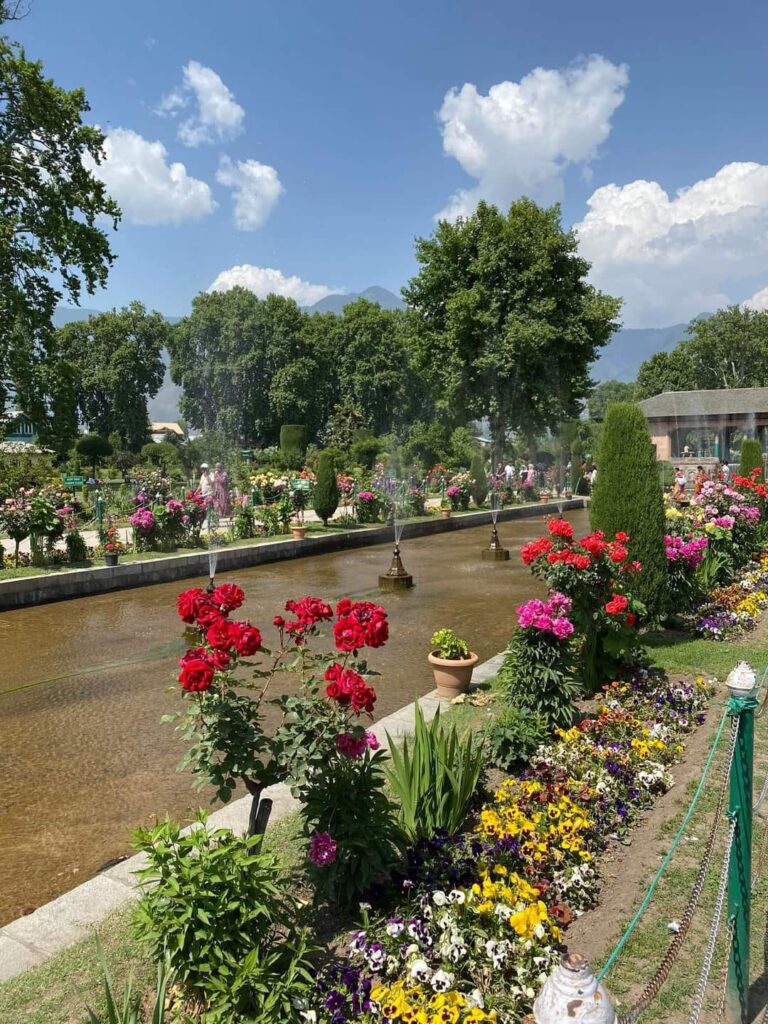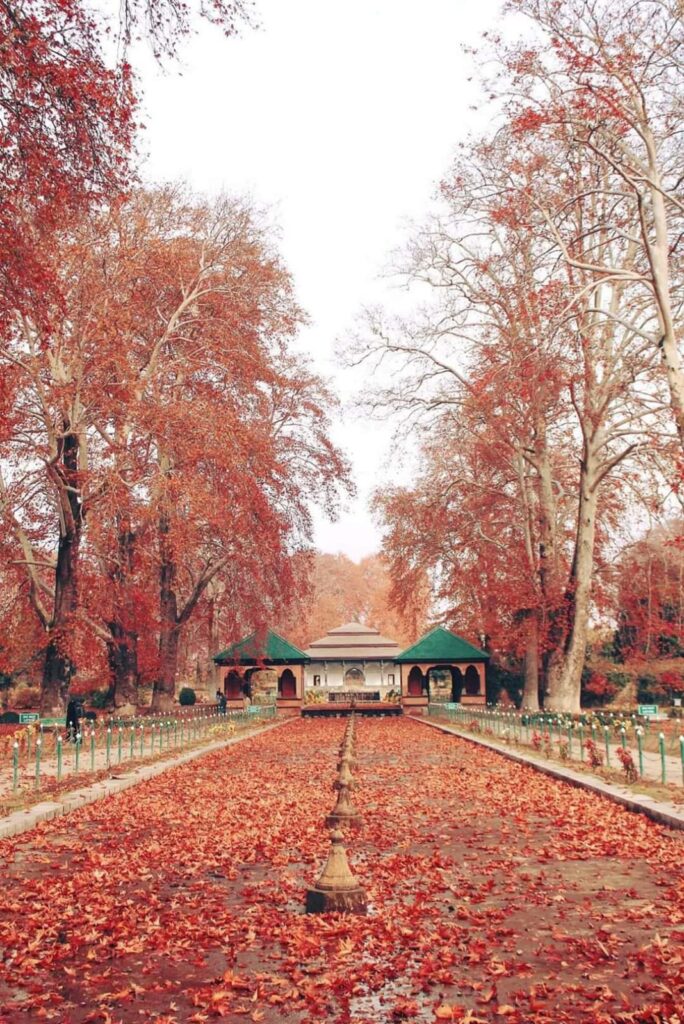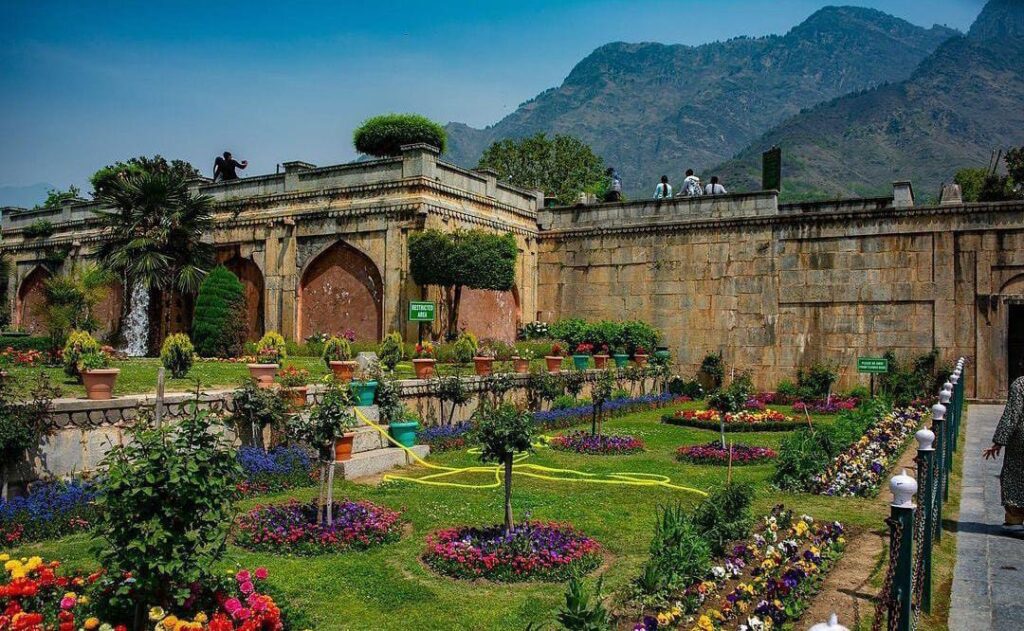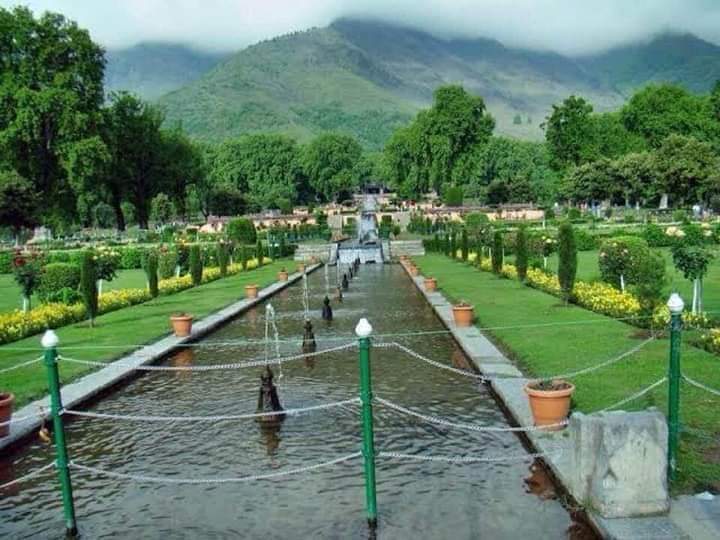


Shalimar Bagh
Shalimar Bagh, also known as the Shalimar Gardens, it is a beautiful garden in Srinagar, a special place in India. It was made a long time ago by a king named Jahangir in the 17th century. He called it “Shalimar,” which means “Home of Love.” The garden was a way for him to show how much he loved Kashmir.
The Shalimar Bagh is very special because it has different levels with fountains, waterfalls, and pretty flower gardens. It’s a big place with three main parts, and each part is unique and Lovely. You can see tall chinar trees, colorful flowers, and carefully made waterways that help cool the place when it’s hot in the summer.
Shalimar Bagh is not just a pretty garden, it’s also a place with a lot of history. Important things happened here during the time of the Mughal Empire, and it was where the kings and queens had parties and celebrations.
Today, Shalimar Bagh is a favorite place for tourists. People from all over the world come here to see its beautiful buildings and gardens. It’s a great example of how the Mughal kings liked art, beauty, and nature.
History of shalimar bagh

Emperor Jahangir wanted to make his queen, Nur Jahan, happy, so he made a special garden for her called Shalimar Bagh. He started this in 1619 by making an old garden bigger and more beautiful. He named it “Farah Baksh,” which means “the delightful,” to show how nice it was.
Later, the ruler of Kashmir, Zafar Khan, made it even bigger in 1630 under Emperor Shah Jahan’s orders and called it “Faiz Baksh,” meaning “the abundant.” After that, other rulers turned it into a place for fun and relaxation.
The marble building in the garden was used as a guesthouse for European guests when Maharaja Ranjit Singh was the ruler. Later, when Maharaja Hari Singh was in charge, they added electricity to the garden. Many emperors worked on making the garden bigger and better over time and gave it different names, but it’s mostly known as “Shalimar Bagh” now.
A long time ago, during the time of the Mughal kings, Emperor Jahangir and his wife Nur Jahan loved Kashmir so much that they visited Srinagar from Delhi at least 13 times during the summer. They would bring their whole royal group with them. Their summer home and royal court were both in Shalimar Bagh. To reach Srinagar, they had to ride elephants over the tough winter passes in the Pir Panjal Himalayan mountains.
Built by Emperor Jahangir (1619)
A long time ago, in 1619, the Mughal Emperor Jahangir decided to make this garden. He wanted to show his love for his wife, Empress Nur Jahan. At first, he called it “Farah Baksh,” which means “The Delightful.”
Changed to Shalimar Garden
Later, Emperor Jahangir changed the name to “Shalimar,” which means “Abode of Love.” This new name showed how much he loved his wife and how he wanted the garden to be a happy place for his family.
Improved by Shah Jahan (mid-17th century)
Another famous Mughal king, Shah Jahan, who built the Taj Mahal, made Shalimar Garden even more beautiful. He added many structures and fountains to make it look stunning.
Neglect during Aurangzeb’s Time (late 17th century)
When Emperor Aurangzeb ruled, the garden didn’t get much attention, and it started to lose its beauty.
Restored and Saved
Over many years, different rulers and people tried to fix and save Shalimar Garden. They wanted to keep its special design and history alive.
UNESCO World Heritage Site (2011)
In 2011, shalimar bagh, along with other Mughal Gardens in the area, got a special title from UNESCO. Due to its significant historical value and cultural significance, the designation “World Heritage Site” was given. This means it’s essential to protect and keep these gardens for the future.
Layout of shalimar bagh
The garden’s design is a bit like the Persian gardens, which are another kind of Islamic garden. It’s shaped like a square on flat ground, with four arms going out from the middle where the water comes from. But they had to change the design because the place had mountains and a well on a higher level that they wanted to use for the garden. So, instead of a square with arms, they made it into a rectangle.
The garden is not too big, about 31 acres in size. There’s a main water channel that goes for about 1,926 feet and is 823 feet wide in total. In the garden, there are three parts with sycamore trees and fountains. The main channel in the middle is called the Shahnahar, and it gives water to the three parts, like a big river.
To get water from the Dal Lake, which is about a mile away, there used to be a canal that was 12 yards wide. Around the lake, there were lots of willow trees and fields of rice. The edge of the lake had rows of chinar trees and wide paths for walking. In the garden, there were paths with trellises and trees planted about 2 feet apart.
The First Terrace (Diwan-e-Aam) of shalimar bagh
The first terrace is like the front part of the garden, where people come in. It has a long water channel running down the middle from north to south. This channel is like the lifeblood of the garden and is very important in Mughal gardens.
There are fountains and waterfalls along this channel, which make the place look pretty and sound relaxing. The terrace also has neat flowerbeds and paths for people to walk on. Big chinar trees grow along the sides of the water channel, and they turn colorful in the fall.
The Second Terrace (Diwan-e-Khas) of shalimar bagh
The second terrace is a bit higher up and is more private than the first one. To reach here, you must climb some stairs. In the middle of this terrace, there is a beautiful black marble building called the Diwan-e-Khas. It has a pavilion on top where the kings used to meet with important guests and enjoy the view. There are also smaller fountains and water channels here, but not as big as in the first terrace. Just like the first one, this terrace has well-arranged flowerbeds.
The Third Terrace of shalimar bagh
The third and highest terrace is where the emperor would go for some peace and quiet. It’s above the second terrace and gives you an amazing view of Dal Lake and the land around it. Even though it doesn’t have big fancy buildings like the lower terraces, it’s a simple and peaceful place. People who visit can enjoy the calm and see some incredible views from up there.
Architecture of shalimar bagh
Let’s celebrate the intricate beauty of the shalimar bagh ,three terraces.
The first terrace of shalimar bagh, known as the public garden, is like a welcoming open space. It leads to the Diwan-e-Aam, where something truly special can be found. Inside this hall, there’s a small, elegant black marble throne placed right above a flowing waterfall. It’s a magnificent combination of architecture and nature that deserves our admiration and awe.
The second terrace of shalimar bagh is a bit wider than the first one, and it has two not-so-steep levels. In the middle of this garden, there’s a special place called the Diwan-e-Khas, which was only for important people invited by the king. In the Diwan-e-Khas, you can still see some stone structures and a pretty platform with fountains around it.
On one side of this garden, there are bathrooms for the royal family. The water flows through this part of the garden in a certain order, first to the Zenana terrace, then to the fountains in the Diwan-e-Khas, then to the Diwan-e-Aam, and finally to the Zenana terrace again. There are a total of 410 fountains in this area.
In the highest part of the shalimar bagh, on the third terrace, there’s a long water channel that goes through a special part called the Zenana garden. This part is surrounded by chinar and Diwan-e-Khas trees. To show that it’s a private area, there are two small buildings, like guard houses, at the entrance. Inside the Zenana garden, there’s a special black marble building called the Black Pavilion, which the king Shah Jahan made.
It has a pool with fountains around it, and behind the building, there’s a waterfall that falls against a short wall with small holes. Next to the Black Pavilion, there’s another small building, and they are both connected by small water channels. At the highest part of the garden, there are two buildings that are shaped like octagons. From there, you can see faraway snow-covered mountains, which is a beautiful sight in the Bagh.
Garden Layout: Shalimar Garden is like a big staircase of greenery going up towards Dal Lake. It looks nice because of this. There are three different levels in the garden, each with special things.
Water Decorations: In Shalimar Garden, there are lots of fountains and water paths. They don’t just look good; they make the garden feel peaceful. The water is set up to make pleasant sounds and pretty sights.
Chinar Trees: Along the main water path, there are big chinar trees. In the fall, they turn bright red and orange, making the garden colorful. These trees give shade and are part of the garden’s design.
Fancy Buildings: In the middle of the garden, there’s a special black marble building called Diwan-e-Khas. It’s really beautiful with lots of fancy designs. Long ago, it was used for important meetings and had great views of the garden. You can also find other nice buildings and resting spots in the garden.
Perfect Shapes: Shalimar Garden is made with perfect shapes and balance. Everything lines up neatly in rows and patterns, which makes it look good.
Inspired by Persia: While Shalimar Garden is mostly Mughal, it also takes ideas from Persian gardens. Persian gardens are known for using water, shapes, and making places feel like paradise. Shalimar does this with its terraces, water, and symmetry.
Nature and Design Together: Shalimar Garden mixes human-made things with nature. The chinar trees, flowing water, and chosen plants all fit together well with the natural surroundings.
Keeping it Nice: Shalimar Garden has been looked after and fixed up over time. People make sure it stays the same as when it was built, so visitors today can still enjoy its beauty and history.
The best time to visit shalimar bagh
The best time to go to Shalimar Garden in Srinagar, Jammu and Kashmir, depends on what kind of weather you like and what you want to see. Each season has something special to offer.
Spring (April to June):
- Spring is the most famous time to visit. The garden is filled with colorful flowers like tulips and daffodils.
- The weather is nice, not too hot or too cold. It’s perfect for walks and picnics.
- But it can be crowded because many tourists come during this time.
Summer (July to September):
- Summer is warm but not too hot, with lush greenery and the soothing sound of water.
- It’s less crowded than spring, so if you like peace and quiet, this is a good time.
Autumn (October to November):
- Autumn is beautiful because the chinar trees turn red and gold, making the garden look stunning.
- The weather is cooler but still comfortable for outdoor activities.
- It’s less crowded than spring, and you can enjoy the fall colors.
Winter (December to March):
- Winter is the cold season, and there’s no blooming flowers. But the garden covered in snow is quite magical.
- If you don’t mind the cold, visiting in winter can be peaceful, and there are very few tourists.
So, you can choose the time that suits your preferences and what you want to experience at Shalimar Garden.
Conclusion of shalimar bagh
Shalimar Garden is a beautiful example of Mughal and Persian garden design. It’s famous for its stepped layout, water features, special chinar trees, and perfect balance. It’s a place where man-made things blend perfectly with nature, making it feel calm and nice. The old buildings, like the Diwan-e-Khas, show how amazing it used to be. Even though it wasn’t always taken care of, people worked hard to keep it nice. Today, it’s a place that reminds us of the great art and culture of its time, where you can relax and enjoy nature and history together.
Discover the Magic of Kashmir’s Natural Beauty in Our New Blog – An Adventure You Can’t Miss! Gulmarg , Dal Lake , Pahalgam , Tulip Garden , Doodhpathri Kashmir , Nishat bagh





